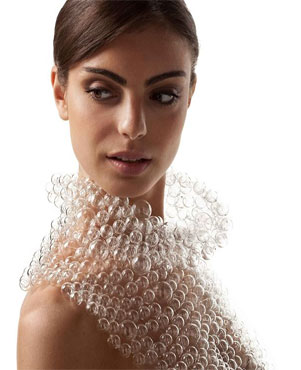 When Venice was an island of wooden structures in the thirteenth century, glassmakers were confined to the neighboring island of Murano. Because of the threat of fire, it was too dangerous to allow them to remain in Venice. The foundries moved in 1291, all the better to isolate the craft and the artisans that revolutionized the alchemy of silica and heat.
When Venice was an island of wooden structures in the thirteenth century, glassmakers were confined to the neighboring island of Murano. Because of the threat of fire, it was too dangerous to allow them to remain in Venice. The foundries moved in 1291, all the better to isolate the craft and the artisans that revolutionized the alchemy of silica and heat.
Susanna and Marina Sent grew up on Murano. Their personal glassmaking lineage reaches back three generations. They came to glassmaking after forays in architecture and jewelry design. Their combined sensibilities form a remarkable synergy of technical skill and modern aesthetics.
Getting to Murano from Venice is a scenic ride on a vaporetto. Briefly, you pass the cemetery island of San Michele and then you arrive at Murano. Disembark at Colonna, the first stop, and you see the Marina e Susanna Sent building rising upon the Fondamenta Serenella, an anomaly of Murano. With its bright, white minimalist form, it heralds the work of artisans who lend a contemporary spirit to this thousand year old tradition.
The exterior courtyard contains a reflecting pool in which clear glass baubles float gently on the surface. It mirrors the building, a linear glass sculpture and the clear blue of the Venetian sky. It reminds you that Venice exists as a unique vibrancy of light, water and atmosphere. Susanna and Marina Sent are driven by scoperta, the thrill of discovery. Originally warned away from working with molten glass, they now find themselves driven by the desire to overcome the boundaries of glassmaking. Their gallery displays jewels, vases and adornments as totems of the physical manifestation of their virtuosity.
They do not follow trends or fashion or a calendar of seasonal whim. Their creations are born of experimentation and technology. To produce colors in glass that have never before existed is a constant goal. The Sent palette is radiant. Susanna calls the colors “strong and not soft.”Even when glass remains clear, its form renders it dramatically translucent. She names Mark Rothko as an inspiration. Both painter and glassmakers have shared the exploration of color as an abstraction. Sculptors also find a place in the sisters’ lexicon. Richard Serra and Anish Kapoor distort space, minimally and extravagantly. Their work is both confrontational and inviting. The jewelry of the Sent sisters is paradoxical as well. The volume of each piece is substantial, its color adds adds gravitas, and yet everything is designed to caress the body. The rigidity of glass is counterbalanced by fluidity.
When Susanna started her exploration of jewelry, she used her father’s nylon fishing line to string together glass beads. With a wry smile she says, “Venetians love their fish.” Recently she has combined the properties of polyester and glass to achieve a rare flexibility that allows glass to conform sensually to the contours of throat, clavicle and breast.
Susanna and Marina Sent often collaborate with designers and artists to realize their vision in glass. To help raise funds for the restoration of the statues of the Virtues at the Palazzo Ducale in Venice, they have collaborated with Philippe Starck on the creation of a spilla virtu, a virtue brooch. The first sculpture to be restored is Fortitude. The brooch is a modern interpretation of her shield. Each piece is made by hand in the technique of casting and grinding. One suspects it is no accident that Fortitude came first. The sisters Sent, descendants of the Murano glass legacy, have prospered in a modern context with a determination born of courage.